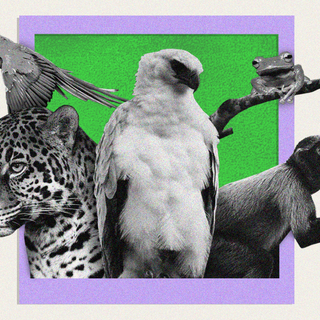The semantics of ape communication is a matter of great human interest. What gesture do they use before they groom each other? What is the “social etiquette” before sitting down to eat? What vocal cue signifies that they are done playing with each other? What call combinations do chimpanzees use among friends and foes?
A new study shows just how complex an interaction between chimpanzees looks like. A single “hoo” among chimpanzees could be a sign of brute force, marked for emitting threats to strangers. A chimpanzee doing it twice is another matter entirely, two “hoos” are reserved only to be used as greetings among those familiar and friendly.
These findings, published in Naturejournal, draw from 5,000 vocal recordings of wild adult chimpanzee calls in Ivory Coast’s Taï National Park. “Our findings highlight a vocal communication system in chimpanzees that is much more complex and structured than previously thought,” said animal researcher Tatiana Bortolato from the Max Planck Institute for Evolutionary Anthropology in Germany. This is a “hidden language” system in its own right, laden with meaning and messages.
There are almost 12different call types chimpanzees exchange among themselves, indicating that the lexicon of chimpanzee communication is significantly richer and more sophisticated than we previously knew. These different call types could be combined in 390 unique vocal sequences – like different kinds of sentences, assembled from combinations of different call types. That chimpanzees have varying call combinations is an observation made before, but the method to these sequences and the meaning carried within was never quite understood.
The complexity lay in the fact that up until now, no one quite knew just how much chimpanzees had to say to each other. The recordings captured almost 12 different call types among chimpanzees; including everything from pants, hoos, grunts to screams, whimpers, barks, and more). How these call types are used, in what combination, and under which context, determined the communication.
“Single grunts, for example, are predominantly emitted at food, whereas panted grunts are predominantly emitted as a submissive greeting vocalization,” the researchers explained in their paper.
Related on The Swaddle:
Fungi May Speak in a Language Similar to Humans
What’s more intriguing is that these 390 sequences could just be the bare minimum number here; there could be several more unique sentences and combinations chimpanzees use but could not be recorded in the current study.
The unique ways in which these call sounds are uttered also impact the meaning and intent of the communication. Imagine a world where a “scream” could not be distinguished from a “pant” or a “hoo.” Language would be chaos if fear is equated with friendship. Understanding the vocal system could then potentially decode hundreds of different meanings.
With this knowledge about our evolutionary cousins, moreover, we also begin to understand how language, the unique and ever-morphing construct, evolves in complex species like ours.
In research published in August last year, scientists found that much like us, chimpanzees make a common gesture — in the form of gazing at each other or making a vocal sound — to signify they’re ready to start and end a social interaction. The sense of commitment when engaging in social interactions isn’t felt by humans alone.
To put it into contex, 390 different sentences may not sound as stellar when compared to human communication. “Whilst this possibility is substantially less than the infinite number of different meanings that can be generated by human language, it nonetheless offers a structure that goes beyond that traditionally considered likely in primate systems,” the researchers noted.
What we take for granted, however, is the ability of human language to weave sounds into words, and words into sentences, with deceptive ease. “By studying the rich complexity of the vocal sequences of wild chimpanzees, a socially complex species like humans, we expect to bring fresh insight into understanding where we come from and how our unique language evolved,” explained senior author Catherine Crockford, a director of research at the Institute for Cognitive Science at CNRS, who was not involved in the study.




